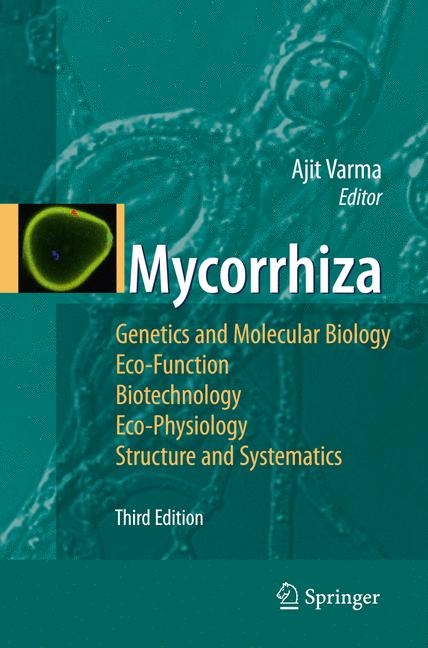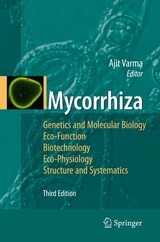Mycorrhiza
Springer Berlin (Verlag)
978-3-540-78824-9 (ISBN)
- Titel erscheint in neuer Auflage
- Artikel merken
Terrestrial ecosystems are driven by microbial guildes. We are, however, severely hampered by our limited understanding of the diversity and function of such mic- bial ecosystems. Growing on mineral particles and decaying organic matter, and l- ing in the vicinity of or within plant roots, are a cast of hundreds of competing versatile and diverse fungal species, including soil decomposers, pathogens, en- phytes and obligate symbionts (Frankland 1998). Amongst the extensive interm- gling webs of hyphae permeating the soil, those of mycorrhizal fungi play a crucial role in ecosystem sustainability through their role in biogeochemical cycles. These mycorrhizal species are no marginal oddity, having been shown to account for half of the fungal species in most temperate, montane and boreal forests. The hyphae of mycorrhizal fungi and plant short roots form a novel composite organ, the so-called mycorrhiza, which is the site of nutrient and carbon transfer between the two sym- otic partners. This mutualistic interactions allow terrestrial plants to grow efficiently in suboptimal environments (Read and Perez-Moreno 2003). They are key drivers of ecosystem function, receiving 15 25% of carbon net productivity and providing most of the host plant nitrogen and phosphorus. The symbiotic relationship between roots and these fungi is undoubtly one of the most prevalent associations in all terrestrial ecosystems.
Ajit Varma is also series editor of our series "Soil Biology".
State of the Art. Mycorrhizal Fungi: What we Know and What should we Know? Diversity, Function and Potential Applications of the Root-Associated Endophytes. Structure, Extension and Functional Significance of Belowground Arbuscular Mycorrhizal Networks. Foraging for Resources in Arbuscular Mycorrhizal Fungi: What is an Obligate Symbiont Searching for and How is it Done? Global Diversity Patterns of Arbuscular Mycorrhizal Fungi-Community Composition and Links with Functionality. Mycorrhiza Helper Bacteria.- Genetics and Molecular Biology. Genomic Organization and Mechanisms of Inheritance in Arbuscular Mycorrhizal Fungi: Contrasting the Evidence and Implications of Current Theories. Ectomycorrhiza and Water Transport. Hypogeous Pezizaceae: Physiology and Molecular Genetics. Evaluation of the Possible Participation of Drought-Induced Genes in the Enhanced Tolerance of Arbuscular Mycorrhizal Plants to Water Deficit.- Eco-Function. The Beneficial Effect of Mycorrhizae on N Utilisation by the Host-Plant: Myth or Reality? Ion Dynamics During The Polarized Growth of Arbuscular Mycorrhizal Fungi: from Presymbiosis to Symbiosis. Arbuscular Mycorrhiza in Metal Hyper-Accumulating Plants. Mycorrhizal Fungi and Other Root Endophytes as Biocontrol Agents Against Root Pathogens. The Biocontrol Effect of Mycorrhization on Soil-Borne Fungal Pathogens and the Autoregulation of the AM Symbiosis: One Mechanism, Two Effects? Resource Partitioning Between Extraradical and Intraradical AM Fungal Mycelium. Ozone Stress and Ectomycorrhizal Root-Shoot Signalling.- Biotechnology. From Production to Application of Arbuscular Mycorrhizal Fungi in Agricultural Systems: Requirements and Needs. Agronomic Management of Indigenous Mycorrhizas. AM Inoculation in Tropical Agriculture: Field Results. The International Market Development for Mycorrhizal Technology . Why and How using Micropropagated Trees rather than Germinations for Controlled Synthesis of Ectomycorrhizal Associations? Biotechnologyand Cultivation of Desert Truffles. The Fungal Transmitted Viruses.- Eco-Physiology. Intertwined Existence: The Life of Plant Symbiotic Fungi in Agricultural Soils. Macroecology of Microbes-Biogeography of the Glomeromycota. Arbuscular Mycorrhiza of Endangered Plant Species: Potential Impacts on Restoration Strategies. Community Developmental Patterns and Ecological Functions of Ectomycorrhizal Fungi: Implications from Primary Succession. Colonization of Plant Roots by Pseudomonads and AM Fungi: A Dynamic Phenomenon, Affecting Plant Growth and Health. In vitro Cultures Open New Prospects for Basic Research in Arbuscular Mycorrhizas. Interactions of Piriformospora indica with Medicinal Plants. In Vivo Assessment of Plants' Vitality: Applications in Detecting and Evaluating the Impact of Mycorrhization on Host Plants.- Structure and Systematics. Edible Mycorrhizal Fungi: Identification, Life Cycle and Morphogenesis. Arbuscular Mycorrhiza in Physiological and Morphological Adaptations of Mediterranean Plants. Novel Symbiotrophic Endophytes. Frankia Nodulation, Mycorrhization and Interactions between Frankia and Mycorrhizal Fungi in Casuarina Plants.-
From the reviews of the third edition:
"The book is arranged in five parts and 36 chapters, each with an introduction, main contents and references. ... All chapters are well referenced ... and there is a good index at the back. ... should be available in all good school, community and university libraries and any research laboratories dealing with agriculture or mycorrhizal research. A good book addressing the mycorrhizal fungi." (K. D. Hyde, Fungal Diversity, Vol. 45, 2010)
| Zusatzinfo | XXXI, 797 p. 5 illus. in color. |
|---|---|
| Verlagsort | Berlin |
| Sprache | englisch |
| Maße | 155 x 235 mm |
| Gewicht | 1285 g |
| Themenwelt | Naturwissenschaften ► Biologie ► Mikrobiologie / Immunologie |
| Schlagworte | Agronomy • Biology • Biotechnology • Ecology • ectomycorrhiza • endomycorrhiza • Forest • forestry • Fungi • Genetics • growth • Molecular Biology • molecular genetics • Morphogenesis • Mycorrhiza • Mykorrhizen • Physiology • Plant • plants • Symbiose • Systematics |
| ISBN-10 | 3-540-78824-7 / 3540788247 |
| ISBN-13 | 978-3-540-78824-9 / 9783540788249 |
| Zustand | Neuware |
| Haben Sie eine Frage zum Produkt? |
aus dem Bereich





